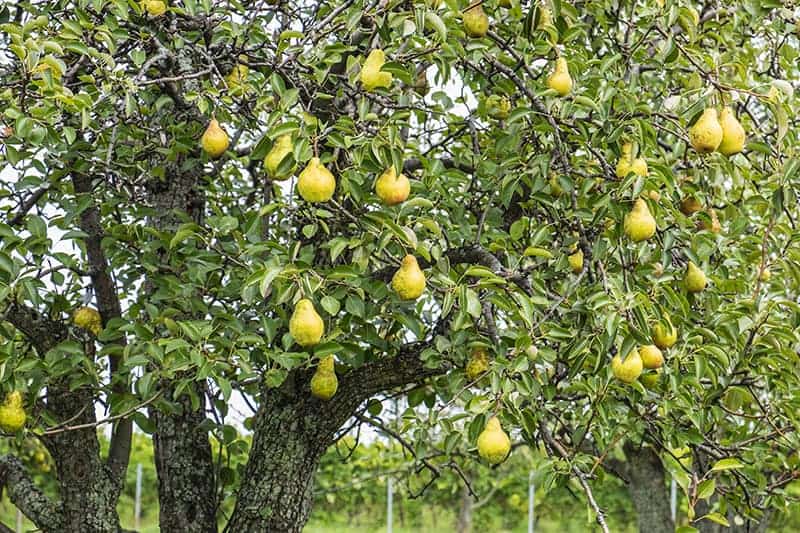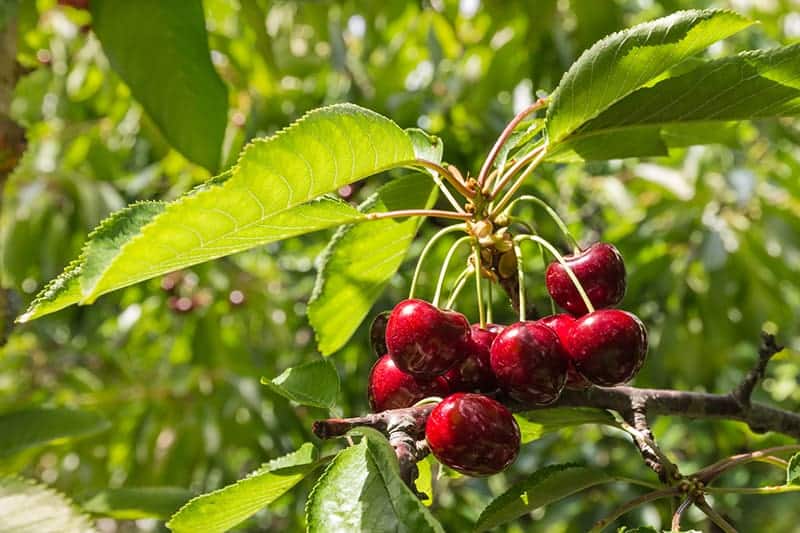- Home >
- Apple Trees
Apple Trees for Sale - Buying & Growing Guide
Do You Know Your Growing Zone? i Growing zones help determine if a particular plant is likely to grow well in a location. It identifies the average annual minimum winter temperatures across the U.S. provided as a map by the USDA.
16 Results
-
Growing Zone(s): 5-8$164.95
-
Growing Zone(s): 5-8$184.95
-
Growing Zone(s): 5-8$199.95
$209.95Save up to 4% -
Growing Zone(s): 5-9$99.95
-
Growing Zone(s): 5-9$114.95
$219.95Save up to 47% -
Growing Zone(s): 5-8$109.95
-
Growing Zone(s): 4-9$109.95
-
Best SellerGrowing Zone(s): 4-8$129.95
-
Growing Zone(s): 4-7$74.95
$94.95Save up to 21% -
Growing Zone(s): 5-9$99.95
$109.95Save up to 9%
Apple Trees – Buying & Growing Guide
One of the easier fruit trees to grow, apple trees can be fun to work with and an attractive addition to your garden. Choose a variety that is resistant to diseases that are common in your region (your local county extension agent can help you with this), and give it a minimum level of care and you’ll be rewarded with a bountiful harvest.
How to Grow Apple Trees
How to plant apple trees
Plant your apple tree where it will get at least six to eight hours of sun every day, in soil that is loamy and fertile. If you are planting multiple trees to ensure pollination, leave adequate space between each tree.
Before planting, unpot your sapling and tease out any roots circling the root ball, since they can choke the tree’s roots. Soak the root ball in a bucket of water for several hours. Dig a hole twice as wide and just as deep as the root ball. Place your tree in the hole with the roots spread out and the graft union two to three inches above ground. Backfill (replace the dirt you removed from the hole) with compost-enhanced soil.
Water your new tree generously. Build a low berm a foot or so out from the trunk so that water stays near the tree and seeps down to the roots. Apply organic mulch, such as leaf mold, around the tree about two to three inches deep and out to the drip line.
How to achieve maximum results
Preparing your soil properly before you plant your tree will go a long way toward ensuring its success. Test your soil if necessary. You’re looking for a pH of between 6.0 and 7.0. If the pH is too low, add garden lime; if it’s too high, add peat moss. Digging compost, manure, or another organic amendment into the soil before you plant your tree can help ensure that your tree gets nourished right from the start.
How to Care for Apple Trees
Watering and nutrients
Your apple tree, once established, needs about an inch of water every ten days. If it rains this amount you won’t need to do any supplemental watering. If you’re experiencing drought conditions, however, a generous watering every ten days to two weeks should be sufficient.
If you have nutrient-rich soil, you won’t need to fertilize your tree until it starts bearing fruit. At that time, your tree will need a high-nitrogen boost. Fertilize in early spring with a product formulated for fruit trees. Follow the package directions, and don’t fertilize after July 1, since the tree needs to stop growing to prepare for winter.
Pollination
Most apple trees are dioecious, which means that you need more than one tree to harvest fruit, since there needs to be cross pollination from one tree to another for fruit to set. Apple trees will cross pollinate with crabapples, which are excellent pollinators. Insects, such as honeybees, do most of the work of moving pollen from the male to the female flowers, although wind also pollinates apple trees.
Pruning
Proper pruning is necessary to keep your apple tree healthy. Prune in the early spring before growth starts, and use sharp, angled cuts that are about one-quarter inch away from a bud. Prune out dead or diseased branches, or branches that are rubbing against each other. Then prune your tree to a “central leader” shape, with one sturdy central branch, and lateral limbs spaced out around it. Prune out some secondary branches so that the interior of your tree gets light and air. Then cut back the leader and secondary branches by about one third to stimulate new growth.
Pests, diseases, and animals
Pests that may bother your apple tree include aphids, apple maggots, bud moths, and codling moths. Orchard sprays, horticultural oil, or neem oil may help with each of these. Your local cooperative extension agent can also give you guidelines on dealing with the prevalent pests or diseases in your region.
Common apple tree diseases include anthracnose, which is a fungus you can control with a copper fungicide or neem oil. Fire blight is a highly contagious disease that causes the fruit and leaves to look like they’ve been scorched. There are sprays specifically for fire blight use. You can also keep the tree site clean and free of debris as a preventative measure.
Small animals, such as mice, can nibble on your tree’s trunk in the winter months. Tree guards or a layer of burlap wrapped around the trunk will help prevent this. Deer may be attracted to the fruit. Although there are deer sprays that may inhibit deer, the only sure way to keep them away is to fence in your trees.
Harvesting
Your apple tree should start bearing fruit three to five years after planting. Apples don’t continue to ripen after they are harvested, so wait for fruit that comes off the branch easily and has a full, reddish color. Better yet, pick one to eat and see if it is sweet and juicy—then you’ll know your tree is ready to harvest.
Types of Apple Trees
1. Granny Smith
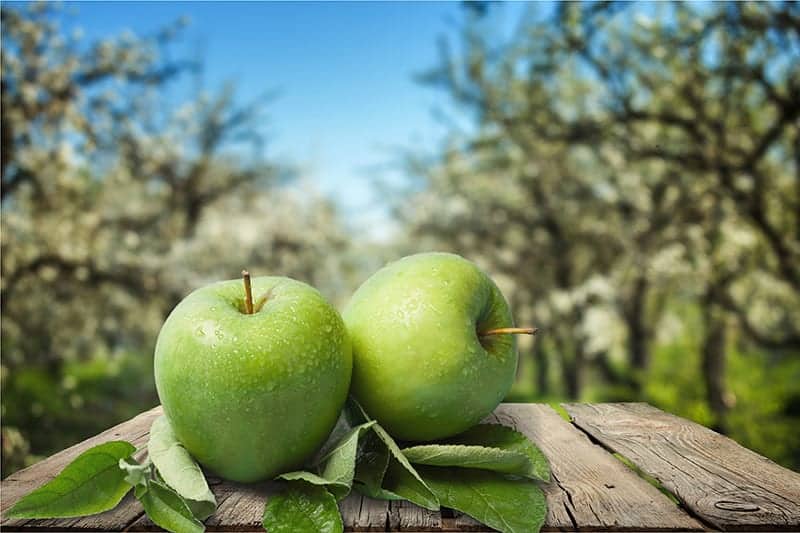
Scientific Name: Malus domestica’ Granny Smith’
Mature Size: Up to 15 feet tall
USDA Hardiness Zone: 5-9
Light: Full sun
Water: Average moisture needs
Soil: Well-draining, deep, fertile
Flower Color: Pink
This deciduous apple tree is native to New South Wales in Australia, where it was discovered in 1868 by its namesake, ‘Granny’ Anne Smith. This is a strong limbed tree that grows as wide as it does tall. In the middle of spring, flowers bloom in clusters along the branches in a pale pink shade. These showy flowers put on a spectacular display and are very popular with bees and butterflies. By the time fall arrives, the flowers will have given way to an abundance of large, bright green fruits.
These apples are best when harvested in October, and due to the fact that the Granny Smith tree thrives in warmer climates than most apple trees, the picking experience should be quite pleasant at this time in the fall. The apples of this tree are enormously popular for their tart and acidic flavor. They are juicy and firm, with a crisp bite. They are wonderful when eaten fresh and raw, but can also be ideal for use in cooking to create sauces and desserts. This tree grows easily in deep, well-draining soils that are relatively fertile. Soil should be kept at a medium moisture level. The tree should be grown in a position of full sun, ideally sheltered from strong winds.
2. Haralson
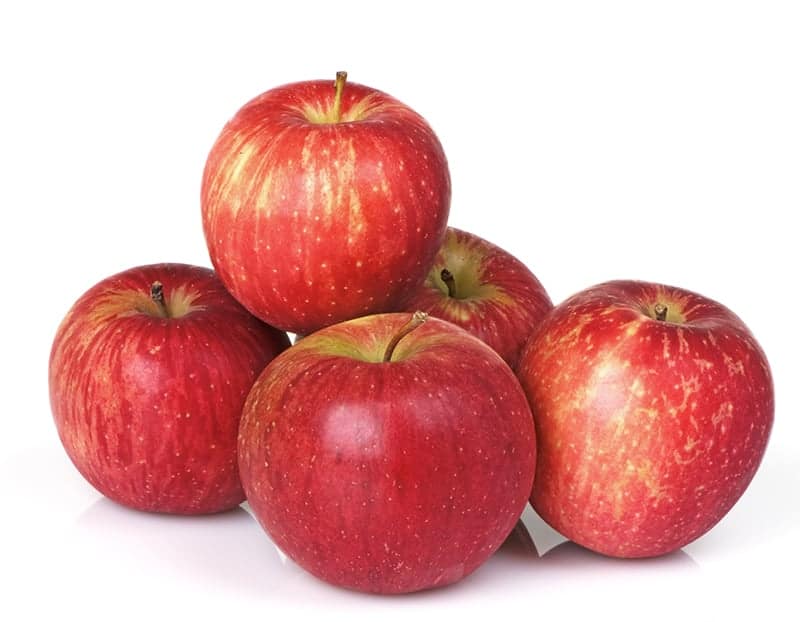
Scientific Name: Malus domestica’ Haralson’
Mature Size: Up to 15 feet tall
USDA Hardiness Zone: 4-8
Light: Full sun
Water: Average moisture needs
Soil: Well-draining, loamy, deep
Flower Color: White
This is a vigorous apple tree that is able to produce fruit in its first year but is known to produce apple biennially thereafter. In mid-spring, clusters of white flowers adorn the lengths of the branches, and these are then followed by a large crop of medium-sized apples in the fall. The apples are two-toned, with red stripes and patches on a yellow-green backdrop. These apples have a mildly tart flavor and are great for eating fresh or using in cooking to make pies or sauces. They also work well in salads due to their mild but juicy characteristics.
This tree is self-fertile, but to increase its fruit yield, it should be pollinated by a different apple tree that blooms at the same time, such as Gala or Honeycrisp. This is a great all-rounder apple tree, looking beautiful in bloom and producing versatile, luscious fruits. It also has an attractive frame, which seems to grow more idyllic with age. Grow this apple tree in a well-draining soil, which is loamy and deep. Water the soil moderately to achieve a medium level of moisture that is neither too wet nor too dry and allow the tree to receive full sun.
3. Jonagold

Scientific Name: Malus domestica’ Jonagold’
Mature Size: Up to 15 feet tall
USDA Hardiness Zone: 5-8
Light: Full sun
Water: Average moisture needs
Soil: Well-draining, acidic, fertile
Flower Color: White
This popular apple tree was developed in New York State in 1943 as a hybrid that was produced by crossing the Golden Delicious apple tree and the Jonathan apple tree. The result is a tree that produces apples with a uniquely sweet and tart flavor. These apples have the much-loved crisp bite of the Golden Delicious, but the taste is not as acidic. The apples are large and have a yellow-green colored skin with flushes of orange-red. The flesh of the apple is pale yellow and very juicy. These are perfect for eating raw or for use in cooking.
The tree looks spectacular in bloom, with a profusion of white flowers appearing in the middle of spring. This tree is not self-fertile, and in order to bear fruits, it will need to be pollinated by another type of apple tree. Choose a different apple tree to plant alongside the Jonagold with the same blooming period, such as the Red Delicious. This tree requires a well-draining soil as it is especially susceptible to root rot. The soil should be slightly acidic and moderately fertile.
4. Honeycrisp

Scientific Name: Malus domestica’ Honeycrisp’
Mature Size: Up to 15 feet tall
USDA Hardiness Zone: 3-9
Light: Full sun
Water: Average moisture needs
Soil: Well-draining, deep
Flower Color: White
This apple tree was developed by the University of Minnesota and is renowned for its ability to thrive in a wide range of climates. It is cold hardy right down to zone 3, being one of the hardiest apple trees around and has a vigorous growth habit. This tree produces snowy white flowers that bloom in the middle of spring. These give way to medium-large sized apples in the fall, which have a yellow-green skin covered in flushes of red.
These delicious apples are popular for their sweet honey flavor and crisp, juicy bite. They are ideal for snacking on raw and also work well in cooking. When stored correctly, these apples have a very long shelf life and can be kept at home for many months and still retain their flavor. This deciduous tree may need to have some support as it grows older. It has a good resistance to fire blight and scab. Grow this tree in full sun, in deep, well-draining soil.
5. Lodi

Scientific Name: Malus domestica’ Lodi’
Mature Size: Up to 25 feet tall
USDA Hardiness Zone: 3-8
Light: Full sun
Water: Average moisture needs
Soil: Well-draining, fertile, deep
Flower Color: White
This apple tree blooms early, at the beginning of spring. It produces pure white flowers that arrive in clusters draped all along the long branches of the tree. These blooms are heavily fragrant and attractive to butterflies and bees. They are followed by a large harvest of apples at the very end of summer. These apples are medium in size, with yellow-green skin. The flesh is pale, with a mild, sweet flavor and a soft bite.
These apples are best enjoyed as apple sauce, or in pies. They freeze very well and are actually better stored in the freezer than the refrigerator. This tree will need to be pollinated by another apple tree with a similar blooming period, such as the Braeburn. This is an attractive apple tree that is cold hardy and produces apples earlier in the season than most others. It also has a greater tolerance for a wide range of soil types than other apple trees but thrives in well-draining, fertile soil.
6. Pink Lady

Scientific Name: Malus domestica’ Pink Lady’
Mature Size: Up to 20 feet tall
USDA Hardiness Zone: 6-9
Light: Full sun
Water: Average moisture needs
Soil: Well-draining, deep
Flower Color: Pink-white
This apple tree is native to Australia and accordingly enjoys long and hot summers. Due to this, it is incredibly popular as a thriving variety of apple tree in the Southwestern United States. This tree blooms in mid-spring, with white flowers that have tinges of pink. The flowers are followed by an abundance of medium to large-sized apples that are ready for harvest in the fall. These apples have a yellow-green base skin color and are flushed with pink-red. Their flesh is firm and juicy, and the flavor is sweet yet tart.
This is the perfect apple for eating fresh or for use in cooking. These apple trees are popular among home growers in warm climates, and they are also a staple in the fruit section of the grocery store. The tree grows best in full sun in well-draining soil.
7. Red Delicious
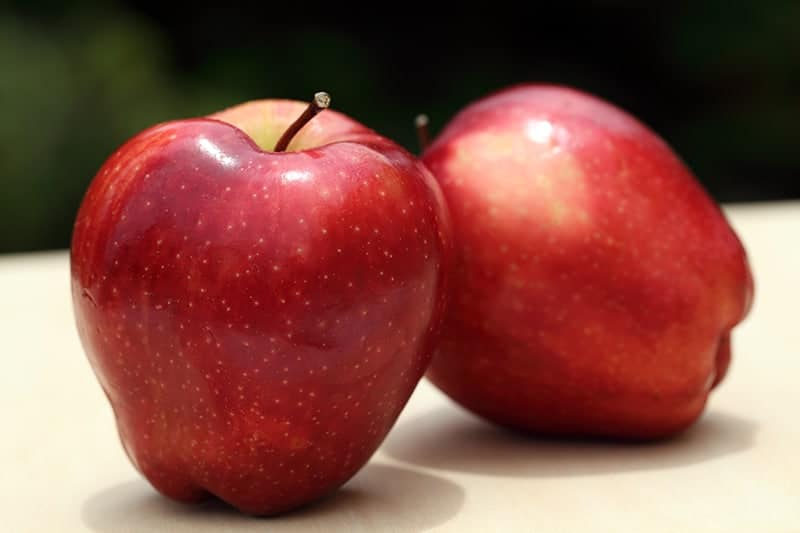
Scientific Name: Malus domestica’ Red Delicious’
Mature Size: Up to 25 feet tall
USDA Hardiness Zone: 5-8
Light: Full sun
Water: Maintain moist soil
Soil: Well-draining
Flower Color: White
This tree dates back to the 1870s and originates in Iowa, US. It is the most extensively cultivated apple tree in the United States and has been for over five decades. It produces fragrant white flowers in the middle of spring, which are followed by striking dark red apples in the fall. These apples are medium to large in size and have smooth and glossy skin. They are sweet and juicy and are most popularly eaten fresh as a snack or in salad dishes.
These apples have a long shelf life and can be kept for up to six months when stored in the refrigerator. The flavor of these apples is at its peak when they are harvested towards the end of September. This apple tree has good resistance to disease and thrives in full sun. It should be grown in a well-draining soil, which is kept consistently moist.
8. McIntosh

Scientific Name: Malus domestica ‘McIntosh’
Mature Size: Up to 20 feet tall
USDA Hardiness Zone: 4-7
Light: Full sun
Water: Average moisture needs
Soil: Well-draining, deep, fertile
Flower Color: White
This apple tree is named after a Canadisan farmer named John McIntosh, who discovered the tree in Ontario in the early 1800s. This deciduous tree is still enormously popular in Canada and the US, both for its beauty as an ornamental tree and its ability to produce delicious fruits. This tree blooms in early to mid-spring with an abundance of fragrant, white flowers. These are followed by apples that arrive early in the season each year, before fall.
The apples have two-toned skin that is deep red and yellow-green. They have a pale flesh that is tender and tangy. They are great for snacking on, but can also be utilized in making apple sauce and dessert pies. This tree has good resistance to disease and is quite hardy in cooler climates. Grow it in full sun in well-draining, deep soil.
9. Gala

Scientific Name: Malus domestica’ Gala’
Mature Size: Up to 16 feet tall
USDA Hardiness Zone: 5-8
Light: Full sun
Water: Average moisture needs
Soil: Well-draining, fertile
Flower Color: White
This tree is native to New Zealand and is known for its easy growth habit and low maintenance care requirements. White flowers bloom on this tree in mid-spring and are followed by medium-sized apples that are ready for harvest in late summer. These fruits have bright red skin, with some creamy-green skin peeking out. These apples are sweet and tangy, with a firm and juicy flesh. They are perfect for eating fresh and also work well when cooked.
They have a long shelf life of up to six months when stored correctly and are resistant to bruising. These characteristics make them popular in grocery stores, as they travel well without spoiling or becoming damaged. Grow these apples in full sun, in moderate climates.
10. Gravenstein

Scientific Name:
Mature Size: Up to 20 feet tall
USDA Hardiness Zone: 2-9
Light: Full sun
Water: Average moisture needs
Soil: Well-draining, loamy, deep
Flower Color: White
This apple tree dates back to the 1700s and originated in Denmark. It is surprisingly cold hardy and is one of the earliest types of apple trees to bear fruit. It produces white flowers in early spring, followed by fruits that are ready for harvest during mid to late summer. The apples are large and have yellow skins with red flushed stripes. With a tart flavor and firm flesh, these apples are great for enjoying fresh and are also popular for making cider and apple sauce. It requires pollination with two other types of apple trees with a similar blooming period. Grow this tree in full sun, in well-draining soil.











